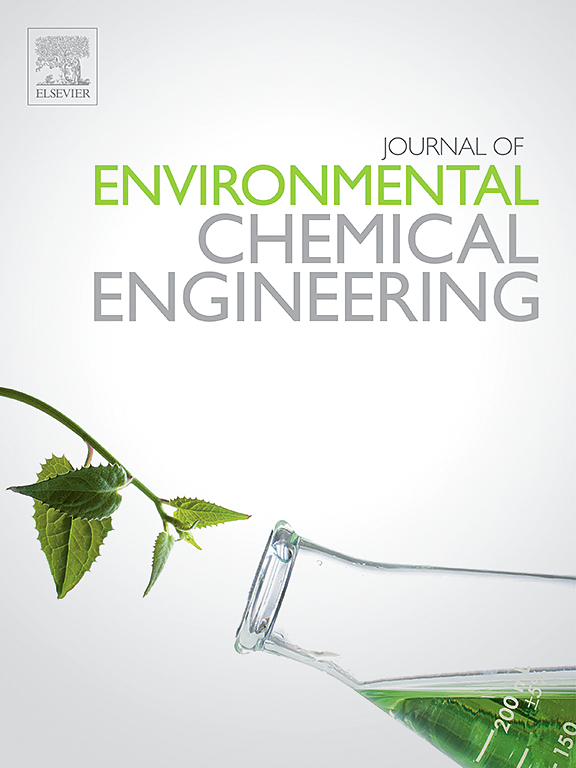Non-radical activation of peracetic acid by Fe-Co sulfide modified activated carbon for the degradation of refractory organic matter
IF 7.4
2区 工程技术
Q1 ENGINEERING, CHEMICAL
引用次数: 0
Abstract
Recently, the non radical activation system had attracted much attention due to its strong anti-interference ability. In this study, a novel FeCo2S4/activated carbon (AC) catalyst was prepared and used to construct a non radical dominated degradation system. Due to the electron-donating groups (C-OH) of AC and the conversion of free radicals generated from the activation of PAA by iron (Fe) and cobalt (Co) ions, a large amount of singlet oxygen (1O2) were produced, making the activation system possessed excellent universality and applicability for the removal of organic pollutants. Within 5 min, about 89.87 % of tetracycline hydrochloride (TCH) was removed in FeCo2S4 /AC + PAA. After only 20 min of reaction, the TCH removal efficiency reached 94.12 %, accompany with the reaction rate reached 0.099 min−1. Other organic pollutants including ibuprofen (IBU), sulfamethoxazole (SMX), ciprofloxacin (CIP), p-nitrophenol (PNP) and atrazine (ATZ) were also efficiently removed within 20 min, with the removal efficiencies were 92.0 %, 91.5 %, 89.4 %, 88.3 %, and 84.5 %, respectively. When the solution pH changed from 5.01 to 9.48, FeCo2S4 /AC also showed excellent catalytic performances, with the TCH removal rates were maintained at over 85.18 %. Moreover, the removal rate of TCH still reached 90.23 % after 5 recycles. This study offered an efficient non-radical peracetic acid (PAA) activation system, which can be effectively used to degrade refractory organic pollutants from complex water environment.
硫化钴铁改性活性炭对过氧乙酸的非辐射活化,用于降解难降解有机物
近年来,非自由基活化体系因其强大的抗干扰能力而备受关注。本研究制备了一种新型的 FeCo2S4/活性炭(AC)催化剂,并将其用于构建非自由基主导的降解体系。由于活性炭中的电子供能基团(C-OH)以及铁(Fe)和钴(Co)离子活化 PAA 产生的自由基的转化作用,产生了大量的单线态氧(1O2),使得该活化体系在去除有机污染物方面具有很好的普遍性和适用性。在 FeCo2S4 /AC + PAA 中,盐酸四环素(TCH)在 5 分钟内就被去除了约 89.87%。仅经过 20 分钟的反应,TCH 的去除率就达到了 94.12%,同时反应速率也达到了 0.099 min-1。其他有机污染物包括布洛芬(IBU)、磺胺甲噁唑(SMX)、环丙沙星(CIP)、对硝基苯酚(PNP)和阿特拉津(ATZ)也在 20 分钟内被有效去除,去除率分别为 92.0%、91.5%、89.4%、88.3% 和 84.5%。当溶液 pH 值从 5.01 变为 9.48 时,FeCo2S4 /AC 也表现出优异的催化性能,三氯氢烷去除率保持在 85.18 % 以上。此外,经过 5 次循环后,三氯乙烷的去除率仍达到 90.23%。该研究提供了一种高效的非辐射过乙酸(PAA)活化体系,可有效用于降解复杂水环境中的难降解有机污染物。
本文章由计算机程序翻译,如有差异,请以英文原文为准。
求助全文
约1分钟内获得全文
求助全文
来源期刊

Journal of Environmental Chemical Engineering
Environmental Science-Pollution
CiteScore
11.40
自引率
6.50%
发文量
2017
审稿时长
27 days
期刊介绍:
The Journal of Environmental Chemical Engineering (JECE) serves as a platform for the dissemination of original and innovative research focusing on the advancement of environmentally-friendly, sustainable technologies. JECE emphasizes the transition towards a carbon-neutral circular economy and a self-sufficient bio-based economy. Topics covered include soil, water, wastewater, and air decontamination; pollution monitoring, prevention, and control; advanced analytics, sensors, impact and risk assessment methodologies in environmental chemical engineering; resource recovery (water, nutrients, materials, energy); industrial ecology; valorization of waste streams; waste management (including e-waste); climate-water-energy-food nexus; novel materials for environmental, chemical, and energy applications; sustainability and environmental safety; water digitalization, water data science, and machine learning; process integration and intensification; recent developments in green chemistry for synthesis, catalysis, and energy; and original research on contaminants of emerging concern, persistent chemicals, and priority substances, including microplastics, nanoplastics, nanomaterials, micropollutants, antimicrobial resistance genes, and emerging pathogens (viruses, bacteria, parasites) of environmental significance.
 求助内容:
求助内容: 应助结果提醒方式:
应助结果提醒方式:


